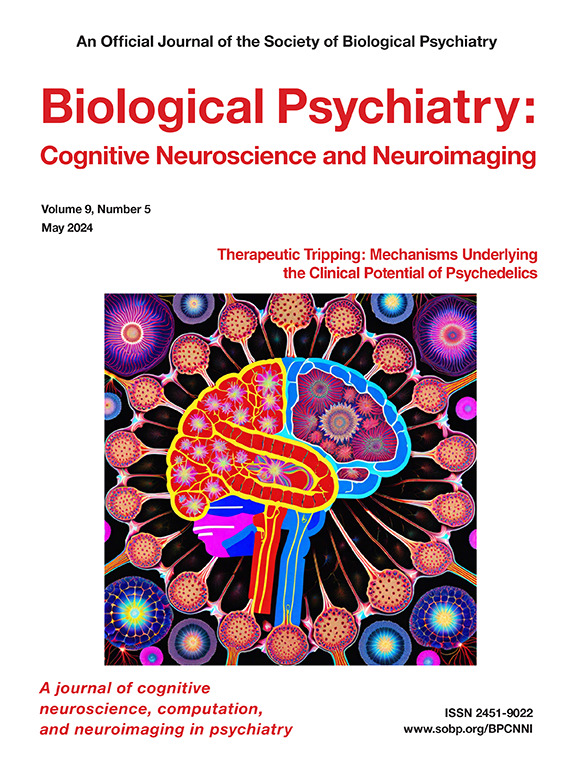Keeping an Eye Out for Change: Anxiety Disrupts Adaptive Resolution of Policy Uncertainty
IF 5.7
2区 医学
Q1 NEUROSCIENCES
Biological Psychiatry-Cognitive Neuroscience and Neuroimaging
Pub Date : 2024-11-01
DOI:10.1016/j.bpsc.2024.07.015
引用次数: 0
Abstract
Background
Human learning unfolds under uncertainty. Uncertainty is heterogeneous with different forms exerting distinct influences on learning. While one can be uncertain about what to do to maximize rewarding outcomes, known as policy uncertainty, one can also be uncertain about general world knowledge, known as epistemic uncertainty (EU). In complex and naturalistic environments such as the social world, adaptive learning may hinge on striking a balance between attending to and resolving each type of uncertainty. Prior work illustrates that people with anxiety—those with increased threat and uncertainty sensitivity—learn less from aversive outcomes, particularly as outcomes become more uncertain. How does a learner adaptively trade-off between attending to these distinct sources of uncertainty to successfully learn about their social environment?
Methods
We developed a novel eye-tracking method to capture highly granular estimates of policy uncertainty and EU based on gaze patterns and pupil diameter (a physiological estimate of arousal).
Results
These empirically derived uncertainty measures revealed that humans (N = 94) flexibly switched between resolving policy uncertainty and EU to adaptively learn about which individuals can be trusted and which should be avoided. However, those with increased anxiety (n = 49) did not flexibly switch between resolving policy uncertainty and EU and instead expressed less uncertainty overall.
Conclusions
Combining modeling and eye-tracking techniques, we show that altered learning in people with anxiety emerged from an insensitivity to policy uncertainty and rigid choice policies, leading to maladaptive behaviors with untrustworthy people.
关注变化:焦虑扰乱了对政策不确定性的适应性解决。
背景介绍人类的学习是在不确定性下展开的。不确定性是多种多样的,不同形式的不确定性会对学习产生不同的影响。一个人可能对如何做才能获得最大回报结果不确定,这被称为政策的不确定性;一个人也可能对一般世界知识不确定,这被称为认识的不确定性。在复杂和自然的环境中,如社会世界,适应性学习可能取决于在关注和解决每种不确定性之间取得平衡。先前的研究表明,焦虑的人--对威胁和不确定性的敏感性增强的人--从厌恶的结果中学到的东西较少,尤其是当结果变得更加不确定时。学习者如何在关注这些不同的不确定性来源之间进行适应性权衡,从而成功地学习他们所处的社会环境?结果:这些根据经验得出的不确定性测量结果显示,人类(N = 94)在解决政策和认识不确定性之间灵活切换,以适应性地了解哪些人可以信任,哪些人应该避免。然而,焦虑增加的人(N = 49)并不能在解决政策和认识不确定性之间灵活切换,相反,他们表达的不确定性总体较低:结合建模和眼动追踪技术,我们发现焦虑症患者对政策不确定性和僵化的选择政策不敏感,从而导致他们对不值得信任的人采取不适应行为,从而改变了他们的学习能力。
本文章由计算机程序翻译,如有差异,请以英文原文为准。
求助全文
约1分钟内获得全文
求助全文
来源期刊

Biological Psychiatry-Cognitive Neuroscience and Neuroimaging
Neuroscience-Biological Psychiatry
CiteScore
10.40
自引率
1.70%
发文量
247
审稿时长
30 days
期刊介绍:
Biological Psychiatry: Cognitive Neuroscience and Neuroimaging is an official journal of the Society for Biological Psychiatry, whose purpose is to promote excellence in scientific research and education in fields that investigate the nature, causes, mechanisms, and treatments of disorders of thought, emotion, or behavior. In accord with this mission, this peer-reviewed, rapid-publication, international journal focuses on studies using the tools and constructs of cognitive neuroscience, including the full range of non-invasive neuroimaging and human extra- and intracranial physiological recording methodologies. It publishes both basic and clinical studies, including those that incorporate genetic data, pharmacological challenges, and computational modeling approaches. The journal publishes novel results of original research which represent an important new lead or significant impact on the field. Reviews and commentaries that focus on topics of current research and interest are also encouraged.
 求助内容:
求助内容: 应助结果提醒方式:
应助结果提醒方式:


